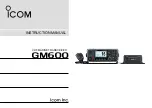
4-3-7. Transmitter
Doublers
The output signal of Q302, L302 goes to an amplifier with tuning circuit Q701, L701, L702
which doubles incoming 13MHz signals.
4-3-8.
Switching of Turning Capacitor in VCO
The VCO circuit must tune with a wide range of frequencies 13.4825MHz ~ 13.7025MHz for
transmitter and 16.27MHz ~16.71MHz for receiver.
To comply above range of VCO, the tuning capacitance should switch for transmission. The
tuning circuit consists with L301, C311, C312, C313, and C314. When the VCO is working as a receiver
Q305 becomes turn OFF. So, L301 and C311, D301 makes turning function.
When transmitting, Q305 becomes ON. S the o, L301 an parallel capacitance of C316 and C311
make turning function.
4-3-9. Receiver Local Oscillator Outputs
z
FIRST MIXER :
The secondary output signal of L107 is injected to the sources of 1’st mixer Q102, Q103 in the
1’st IF mixer section.
z
SECOND MIXER :
The output of 10.24MHz oscillator circuit with X101 is injected into the IF IC(IC101) internally.
Incoming IF signal and 10.24MHz signal are mixed inside the IF IC to extract 2’nd IF signal 455KHz.
FM audio Signals are recovered with the way of quadrature detector.
AM signals are recovered with envelope detector.
4-4.
Frequency Stability
Let
: Fo = Crystal oscillator frequency
Fr = Phase detector reference frequency
Fvco = VCO frequency
Ft = Transmit frequency
Then
: Receiver : Fr = Fo/900
Transmitter : Fr = Fo/1800
And under locked conditions : Fr = Fvco / N
Where, “N” is the programmable divider divide ratio.
Then
: Fvco = N X Fr)
From which it can be seen, the percentage error in Ft is the same as the percentage error in Fo.
The stability of the crystal oscillator is determined primarily by the crystal itself and having lesser
deviation by the active and passive components of the oscillator. The choice of crystal and components is
such that the required frequency stability is maintained over the required voltage and temperature range.
Summary of Contents for Freequency TCB-770
Page 31: ...5 1 Main PCB Top side SECTION5 BOARD LAYOUT ...
Page 32: ...Main PCB Bottom side ...
Page 33: ...5 2 Front PCB Top side ...
Page 34: ...Front PCB Bottom side ...
Page 35: ...5 3 LED PCB Top side ...
Page 36: ...LED PCB Bottom side ...
Page 37: ...5 4 Volume PCB ...
Page 38: ...5 5 MIC PCB ...
Page 39: ...SECTION6 BLOCK DIAGRAM ...
Page 40: ...SECTION7 SCHEMATIC ...















































